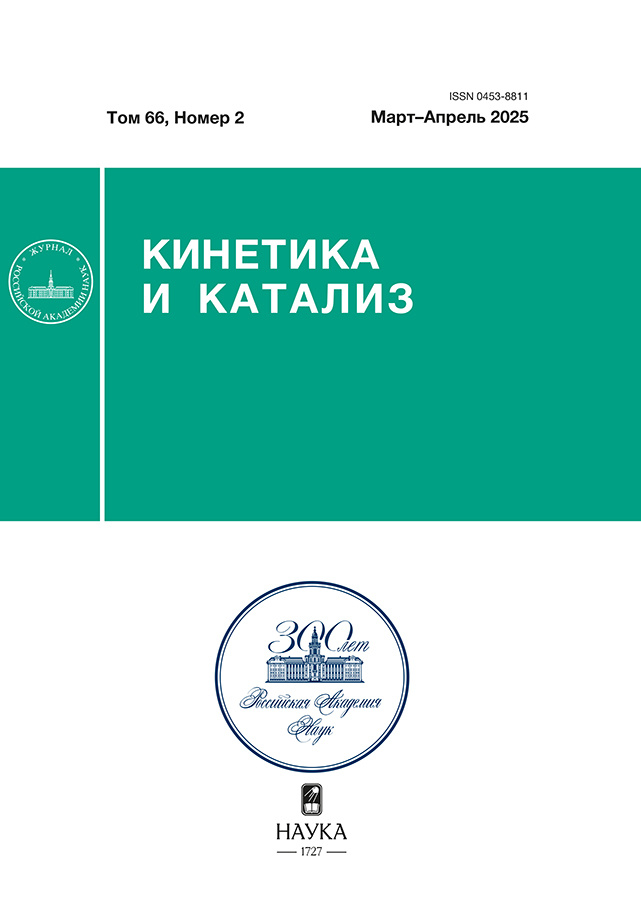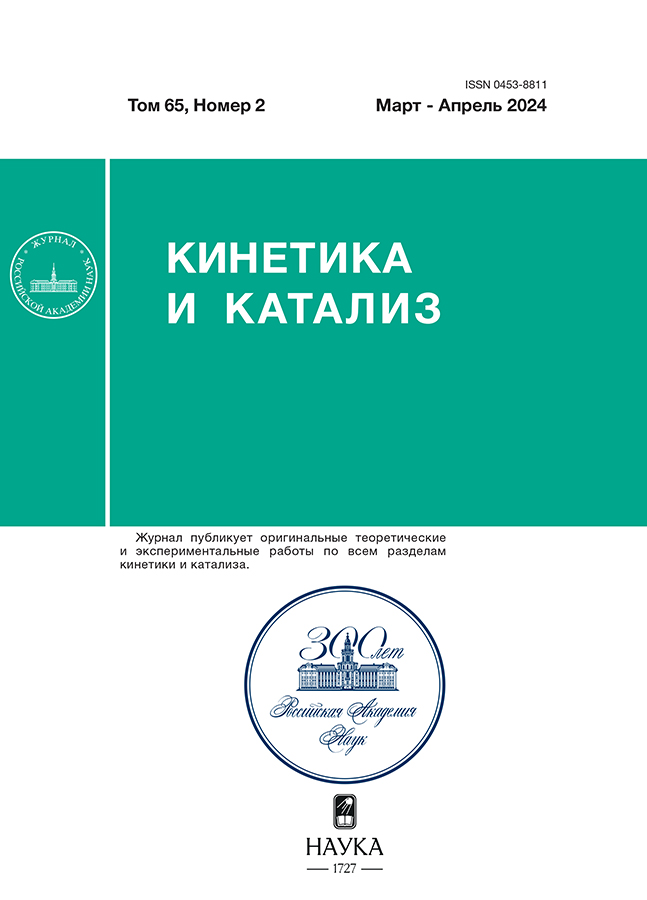Influence of iron content in palladium catalysts supported on alumina and their reduction conditions on the hydrodechlorination of diclofenac in aqueous solutions
- Authors: Lokteva E.S.1, Pesotskiy M.D.1, Golubina E.V.1, Maslako K.I.1, Kharlanov A.N.1, Shishova V.V.1, Kaplin I.Y.1, Maksimov S.V.1
-
Affiliations:
- Lomonosov Moscow State University
- Issue: Vol 65, No 2 (2024)
- Pages: 148-172
- Section: ARTICLES
- URL: https://medjrf.com/0453-8811/article/view/660337
- DOI: https://doi.org/10.31857/S0453881124020054
- EDN: https://elibrary.ru/DWUAEN
- ID: 660337
Cite item
Abstract
Using the method of wet impregnation of alumina with iron and palladium nitrates, 1Pd0.5Fe and 1Pd10Fe catalysts modified with iron oxides were prepared with a target content of 1 wt % Pd, 0.5 or 10 wt % iron. The catalysts were compared with each other and with the monometallic catalyst 1Pd in the hydrodechlorination (HDC) of diclofenac (DCF) in dilute aqueous solutions at 30°C in batch and flow reactors after high-temperature (320°C) and mild (30°C) reduction; the latter was carried out in a batch or flow reactor. Using X-ray photoelectron spectroscopy (XPS), it was shown that after reduction at 320°C the surface of catalysts contains mainly Pd0, Fe2+ and Fe3+. The surface Fe2+/Fe3+ ratio increases as the iron content decreases. The reduction of Pd2+ to Pd0 is possible already at 30°C, but it proceeds much worse on the surface of 1Pd0.5Fe compared to 1Pd10Fe. According to XPS data, temperature-programmed reduction and infrared spectroscopy of diffuse reflection of adsorbed CO, modification with iron oxides increases the palladium content on the surface compared to 1Pd, promotes the emergence of new Pd–O–Fe centers, and affects the ability of palladium to be reduced. These effects increase with increasing iron content. Iron-modified catalysts reduced at 320°C showed similar activity and stability in the conversion of DCP in flow-through and batch systems. Unlike 1Pd0.5Fe, the 1Pd10Fe catalyst is highly efficient and stable even after mild reduction at 30°C. Under flow conditions with comparable DCF conversion, it provides increased selectivity in the HDC reaction of diclofenac compared to 1Pd, which is also active in hydrogenation.
Full Text
About the authors
E. S. Lokteva
Lomonosov Moscow State University
Author for correspondence.
Email: LES@kge.msu.ru
Chemistry Department
Russian Federation, Leninskie Gory, 1, building 3, Moscow, 119991M. D. Pesotskiy
Lomonosov Moscow State University
Email: LES@kge.msu.ru
Chemistry Department
Russian Federation, Leninskie Gory, 1, building 3, Moscow, 119991E. V. Golubina
Lomonosov Moscow State University
Email: LES@kge.msu.ru
Chemistry Department
Russian Federation, Leninskie Gory, 1, building 3, Moscow, 119991K. I. Maslako
Lomonosov Moscow State University
Email: LES@kge.msu.ru
Chemistry Department
Russian Federation, Leninskie Gory, 1, building 3, Moscow, 119991A. N. Kharlanov
Lomonosov Moscow State University
Email: LES@kge.msu.ru
Chemistry Department
Russian Federation, Leninskie Gory, 1, building 3, Moscow, 119991V. V. Shishova
Lomonosov Moscow State University
Email: LES@kge.msu.ru
Chemistry Department
Russian Federation, Leninskie Gory, 1, building 3, Moscow, 119991I. Yu. Kaplin
Lomonosov Moscow State University
Email: LES@kge.msu.ru
Chemistry Department
Russian Federation, Leninskie Gory, 1, building 3, Moscow, 119991S. V. Maksimov
Lomonosov Moscow State University
Email: LES@kge.msu.ru
Chemistry Department
Russian Federation, Leninskie Gory, 1, building 3, Moscow, 119991References
- Xu S., Zhou S., Xing L., Shi P., Shi W., Zhou Q., Pan Y., Song M.-Y., Li A. // Sci. Total Environ. 2019. V. 682. P. 756.
- Zhao J., Wang Q., Fu Y., Peng B., Zhou G. // Environ. Sci. Pollut. Res. 2018. V. 25. P. 22998.
- Umbreen N., Sohni S., Ahmad I., Khattak N.U., Gul K. // J. Colloid Interface Sci. 2018. V. 527. P. 356.
- Gros M., Petrović M., Barceló D. // Environ. Tox. Chem. 2007. V. 26. P. 1553.
- Dobrin D., Bradu C., Magureanu M., Mandache N.B., Pârvulescu V.I. // Chem. Eng. J. 2013. V. 234. P. 389.
- Lokteva E., Golubina E., Likholobov V., Lunin V., Disposal of Chlorine-Containing Wastes / In: Chemistry Beyond Chlorine, Springer International Publishing. Eds. P. Tundo, L.-N. He, E. Lokteva and C. Mota, Cham, 2016. 559 p. https://doi.org/10.1007/978-3-319-30073-3_21
- Munoz M., Mora F.J., de Pedro Z.M., Alvarez-Torrellas S., Casas J.A., Rodriguez J.J. // J. Hazard. Mater. 2017. V. 331. P. 45.
- Nieto-Sandoval J., Munoz M., de Pedro Z.M., Casas J.A. // J. Hazard. Mater. Adv. 2022. V. 5. P. 100047.
- Lokteva E.S., Shishova V.V., Maslakov K.I., Golubina E.V., Kharlanov A.N., Rodin I.A., Vokuev M.F., Filimonov D.S., Tolkachev N.N. // Appl. Surf. Sci. 2023. V. 613. P. 156022.
- Wu K., Qian X., Chen L., Xu Z., Zheng S., Zhu D. // RSC Adv. 2015. V. 5. P. 18702.
- Nieto-Sandoval J., Munoz M., de Pedro Z.M., Casas J.A. // Chemosphere. 2018. V. 213. P. 141.
- Zhou T., Li Y., Lim T.-T. // Separ. Purif. Technol. 2010. V. 76. P. 206.
- Liu M., Huang R., Li C., Che M., Su R., Li S., Yu J., Qi W., He Z. // Chem. Eng. Sci. 2019. V. 201. P. 121.
- Witońska I.A., Walock M.J., Binczarski M., Lesiak M., Stanishevsky A.V., Karski S. // J. Mol. Catal. A: Chem. 2014. V. 393. P. 248.
- Zhang L., Meng Z., Zang S. // J. Environ. Sci. 2015. V. 31. P. 194.
- Lokteva E.S., Shishova V.V., Tolkachev N.N., Maslakov K.I., Kamaev A.O., Maksimov S.V., Golubina E.V. // Mendeleev Commun. 2022. V. 32. P. 249.
- Silva J.M., Araújo J.F.D.F., Brocchi E., Solórzano I.G. // Ceram. Int. 2020. V. 46. P. 19052.
- Th P., Zimmermann R., Steiner P., Hüfner S. // J. Phys. Condens. Matter. 1997. V. 9. P. 3987.
- Amoyal M., Vidruk-Nehemya R., Landau M.V., Herskowitz M. // J. Catal. 2017. V. 348. P. 29.
- Armenta M.A., Maytorena V.M., Flores-Sánchez L.A., Quintana J.M., Valdez R., Olivas A. // Fuel. 2020. V. 280. P. 118545.
- Tian Z., Zhang W., Liu T., Liu J., Wang C., Lei L., Liao M., Wang C., Chen Y. // Int. J. Hydrogen Energy. 2022. V. 47. P. 41468.
- Han X., Qing M., Wang H., Yu X., Suo H.-Y., Shen X.-F., Yang Y., Li Y.-W. // J. Fuel Chem. Technol. 2023. V. 51. P. 155.
- Lu Z.-Y., Muir D.M. // Hydrometallurgy. 1988. V. 21. P. 9.
- Tao F., Dag S., Wang L.-W., Liu Z., Butcher D.R., Bluhm H., Salmeron M., Somorjai G.A. // Science. 2010. V. 327. P. 850.
- Boudart M., Hwang H.S. // J. Catal. 1975. V. 39. P. 44.
- Babu N.S., Lingaiah N., Kumar J.V., Prasad P.S.S. // Appl. Catal. A: Gen. 2009. V. 367. P. 70.
- Lieltz G., Nimz M., Völter J., Läzär K., Guczi L. // Appl. Catal. 1988. V. 45. P. 71.
- Berry F.J., Changhai X., Jobson S. // J. Chem. Soc. Faraday Trans. 1990. V. 86. P. 165.
- Arnoldy P., Moulijn J.A. // J. Catal. 1985. V. 93. P. 38.
- Arnoldy P., van Oers E.M., Bruinsma O.S.L., de Beer V.H.J., Moulijn J.A. // J. Catal. 1985. V. 93. P. 231.
- Sepúlveda J.H., Fígoli N.S. // Appl. Surf. Sci. 1993. V. 68. P. 257.
- Pino N., Sitthisa S., Tan Q., Souza T., López D., Resasco D.E. // J. Catal. 2017. V. 350. P. 30.
- Liu W., Ismail M., Dunstan M.T., Hu W., Zhang Z., Fennell P.S., Scott S.A., Dennis J.S. // RSC Adv. 2015. V. 5. P. 1759.
- Tataroğlu A., Al-Ghamdi A.A., El-Tantawy F., Farooq W.A., Yakuphanoğlu F. // Appl. Phys. A. 2016. V. 122. P. 220.
- Jastrzębska I., Szczerba J., Błachowski A., Stoch P. // Eur. J. Mineral. 2017. V. 29. P. 62.
- Yewale A.D., Kherdekar P.V., Bhatia D. // Chem. Eng. Sci. 2022. V. 249. P. 117281.
- Kamada T., Ueda T., Fukuura S., Yumura T., Hosokawa S., Tanaka T., Kan D., Shimakawa Y. // J. Am. Chem. Soc. 2023. V. 145. P. 1631.
- Schwertmann U. // Plant and Soil. 1991. V. 130. P. 1.
- Sidhu P.S., Gilkes R.J., Cornell R.M., Posner A.M., Quirk J.P. // Clays and Clay Minerals. 1981. V. 29. P. 269
- Kolev N.I. Solubility of O2, N2, H2 and CO2 in water / In: Multiphase Flow Dynamics 4: Turbulence, Gas Adsorption and Release, Diesel Fuel Properties. Ed. N.I. Kolev. Berlin, Heidelberg: Springer, 2012.209 р. https://doi.org/10.1007/978-3-642-20749-5_11
Supplementary files






















